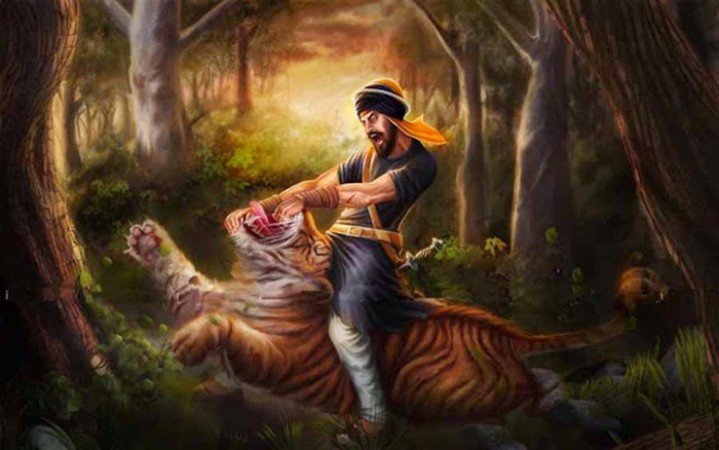
Hari Singh Nalwa was raised in a Sukerchakia Misl Rangreta Sikh family. Majitha, a small town close to Amritsar, was the family's hometown. Hardas Singh, his grandfather, had lost his life in 1762 while defending himself from Ahmad Shah Durrani. Gurdial Singh, his father, had participated in a number of the Sukkarchakkia campaigns led by Mahari Singh and Charat Singh Sukkarchakia.
The most volatile North West Frontier of Ranjit Singh's empire was under the command of Hari Singh Nalwa. To the very mouth of the Khyber Pass, he followed the Sarkar Khalsaji boundary. This route into the subcontinent had been exploited for the previous eight centuries by marauders who had engaged in rape, pillage, plunder, and forced conversions to Islam. The vicious tribes that lived in these areas grew to fear Hari Singh during his lifetime. The last foreign incursion into the subcontinent was successfully repelled by him at Jamrud through the Khyber Pass, thus closing this path for the invaders. Hari Singh Nalwa's legendary status even after his death assured the Sikhs' victory over an Afghan force five times as large.
Also Read:Akali Baba Phoola Singh : A Warrior
The accomplishments of Hari Singh Nalwa as a military leader and administrator in the North West Frontier remain unparalleled. Even after two centuries, attempts to impose law and order in this region by Britain, Pakistan, Russia, and America have failed. Hari Singh Nalwa was recognized as the "Champion of the Khalsa" because of his extraordinary accomplishments, which perfectly reflected the tradition started by Guru Gobind Singh.
In 1804, Hari Singh participated in a recruitment test for service in the Sikh army and so impressed Maharaja Ranjit Singh with his skill at various drills that he was given an appointment as a personal attendant. Not long after, in 1805, he received the commission with a command of 800 horses and foot and was given the title of 'Sardar' (Chief).
Also Read:Maharaja Sher Singh: Sikh Sovereign
According to a historical account, the incident in which he used a sword to chop off the head of a tiger that had grabbed him was what led to his swift advancement from the Maharaja's attendant to command of 800 riders. Since that time, he has been referred to as "Baaghmaar" (meaning "the tiger killer") and has been given the name "Nalwa" (meaning "one with claws like a tiger"). Another historical account of the tiger event gives a different account, stating that the term "Nalwa" was added to his name after he "had killed a tiger single-handed on horseback, with the sacrifice, however, of his horse."
Hari Singh went on to participate in many glorious victories of the Sikhs before becoming the Commander-in-Chief of the army along the North Western Frontier of the Sikh Kingdom He was appointed Governor of various provinces and was one of the wealthiest jagirdars of the Kingdom.
Also Read:Rani Jind Kaur: Last Queen Of Sikhs
Dost Mohammad Khan was not satisfied and after using all of his resources sent his son Akbar to retake Peshawar in the year 1837, which he successfully did. As a result, Sardar Hari Singh Nalua was sent to lead the Lahore forces in combat with the Afghans. He dispatched his troops to Peshawar. This time, Jamrud served as the battleground where a fierce war was conducted. Fort of Jamrud, built by Sardar Hari Singh Nalua and controlled by Sardar Mahan Singh Mirpura, stood at the gateway to the Khyber Pass. Nalua laboured incredibly hard despite the lack of men and supplies for the war, but he never lost his heart. For materials, urgent messages were dispatched to Lahore and Peshawar.
For want of timely help, the Sardar was, of course, killed but the Afghans could not dislodge the 500 Punjabi troops from the fort of Jamrud. General Hari Singh Nalua give his last command to his men to not to disclose his death and continue giving the enemy a good fight.
Also Read:Guru Angad Dev Ji: Gurmukhi Script
Sir Lepel Gryphon provides a thorough analysis of Sardar Nalua's campaign in Jamrud. He notes that Sardar was given the go-ahead to construct a fort at Jamrud, which is located at the Khyber pass's entrance and from whose walls the Maharaja could see Jalalabad, Afghanistan. Sardar constructed a small harbour that was remarkably impervious to artillery fire and could withstand repeated bombardment for several weeks. With 7,000 horses, 2000 matchlock soldiers, and 18 guns, the Dost Mohammad Khan. His three sons joined the main force and began battering the fort with their respective forces, along with a force of 12,000 to 15,000 Khaibiris. When Hari Singh Nalua was sick with a fever in Peshawar, Mahan Singh Mirpura asked for assistance.
Also Read:Guru Ram Das Ji: Developed Amritsar
As soon as further reinforcements were needed, Hari sent some riders to Lahore, and he and his army marched to Jamrud. The garrison was given new life by reinforcements under Hari Singh Nalua, and the Afghani invasion was fiercely repelled. Gryphon claims that Hari Singh Nalua was hit by two balls, one in the side and the other in the stomach, as he and roughly five of his companions left the fort to investigate a hole in a wall. The Nalua Sardar rode as far as his camp even though they knew he was gravely wounded to prevent the men from losing heart. Then, while still on the ground, he issues his few trusted troops one final directive: disclose the secret of his death. Hari Singh further imparted instructions to his soldiers to cover his dead body after lifting it from the ground and placing it on a cot. Thus the great Sardar Hari Singh Nalua, with the terror of whose name Afghan mothers used to quieten their fretful children attained his martyrdom.